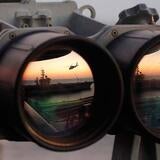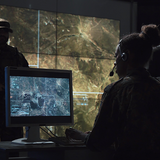By Ian Charles
Managing Director, Space & Airborne Systems, L3Harris Australia
As the sun rose over the Pacific Ocean today, it illuminated a region much different – and more dangerous – than just a few years ago.
As highlighted by Australian Deputy Prime Minister Richard Marles in his Shangri-La Dialogue defence summit speech in June this year, the illegitimate claims, belligerent activities and overall adversarial posturing from China have made it necessary for nations to update their strategies. Calling for regional partners and allies to strengthen our individual and collective deterrence to build a sustainable balance of power in the Indo-Pacific, in which no one country in our region is militarily dominant.
Key to this new approach is the AUKUS Trilateral Security Partnership among the U.S., U.K. and Australia, designed to counter Indo-Pacific threats on an unambiguous basis. As the partnership marks its third anniversary this month, it is showing how strength and international cooperation are the cornerstones to maintaining peace.
The AUKUS Pillar 1 initiative covering Australia’s acquisition of conventionally armed nuclear-powered submarines has garnered the most attention. But there is another extremely important capability vital to the partnerships’ success – Electronic Warfare (EW).
EW translates to having the capability to control, exploit and defend the use of the electromagnetic spectrum to AUKUS partners’ advantage. It ensures data flows are unimpeded and uninterrupted while denying the same to adversaries. Global dependence on Electromagnetic Spectrum Operations poses new and dynamic threats, requiring a proactive, integrated and cross domain approach to EW capabilities.
In Australia, it's about making sure the Australian Defence Force is able to force project and protect by being the most informed, the most connected and the most capable of using the power of information, in all its forms, without any fear of compromise or denial.
AUKUS Pillar 2 designates EW as a key advanced capability that is needed for success. The Australian government’s National Defence Strategy emphasizes the importance of joint EW research and development with the U.S. and U.K.
The Integrated Investment Program earmarks $2.7-$3.7 billion through 2033-34 to develop and integrate electronic warfare capabilities.
L3Harris has been a vital partner on the ADFs EW capabilities for many years. While the company has operated in Australia for decades, it recently launched the new Centre for Excellence for Electronic Warfare in Brisbane to develop new capabilities at the needed pace for today’s environment.
L3Harris continues working directly with partners to help Australia enhance sovereign defence industrial capabilities as part of the formal Global Supply Chain. This will support the continued growth of Australian companies, enabling them greater access to supply the global defence marketplace.
International partnerships, coalition operations and shared security interests are clearly vital to success in the Indo-Pacific. Key to those relationships is collaboration with governments and industry partners to:
- Discuss these topics in a trusted setting.
- Debate contemporary real-life examples of threats.
- Collaborate on innovative solutions to build products to address these threats.
With the AUKUS partnership as an enabler, opportunities among the partner nations will only expand and enhance the capabilities of Real-Time Spectrum Operations and fortify global defence relationships.
With AUKUS’ success, soon the sun will rise over a more stable, more peaceful Pacific Ocean.










